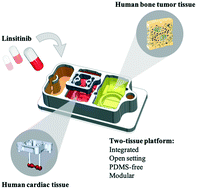Integrated human organ-on-a-chip model for predictive studies of anti-tumor drug efficacy and cardiac safety†
Abstract
Traditional drug screening models are often unable to faithfully recapitulate human physiology in health and disease, motivating the development of microfluidic organs-on-a-chip (OOC) platforms that can mimic many aspects of human physiology and in the process alleviate many of the discrepancies between preclinical studies and clinical trials outcomes. Linsitinib, a novel anti-cancer drug, showed promising results in pre-clinical models of Ewing Sarcoma (ES), where it suppressed tumor growth. However, a Phase II clinical trial in several European centers with patients showed relapsed and/or refractory ES. We report an integrated, open setting, imaging and sampling accessible, polysulfone-based platform, featuring minimal hydrophobic compound binding. Two bioengineered human tissues – bone ES tumor and heart muscle – were cultured either in isolation or in the integrated platform and subjected to a clinically used linsitinib dosage. The measured anti-tumor efficacy and cardiotoxicity were compared with the results observed in the clinical trial. Only the engineered tumor tissues, and not monolayers, recapitulated the bone microenvironment pathways targeted by linsitinib, and the clinically-relevant differences in drug responses between non-metastatic and metastatic ES tumors. The responses of non-metastatic ES tumor tissues and heart muscle to linsitinib were much closer to those observed in the clinical trial for tissues cultured in an integrated setting than for tissues cultured in isolation. Drug treatment of isolated tissues resulted in significant decreases in tumor viability and cardiac function. Meanwhile, drug treatment in an integrated setting showed poor tumor response and less cardiotoxicity, which matched the results of the clinical trial. Overall, the integration of engineered human tumor and cardiac tissues in the integrated platform improved the predictive accuracy for both the direct and off-target effects of linsitinib. The proposed approach could be readily extended to other drugs and tissue systems.

- This article is part of the themed collection: organ-on-a-chip systems: translating concept into practice


 Please wait while we load your content...
Please wait while we load your content...
